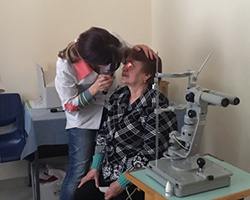Armenia – targeted screening approach aims to prevent diabetic sight loss

WHO
13 November 2020
The prevention and treatment of diabetes as a public health threat is a priority for the Armenian Ministry of Health. Working with partners, it leads a number of projects to address the various complications of the disease.
It is estimated that approximately 96 000 people in Armenia have diabetes, and the number is rising. A lack of resources, inadequate public awareness and a shortage of specialists all stand in the way of implementing an effective screening programme across the country. Access to health care is uneven, and although ophthalmic medical practitioners carry out screenings in polyclinics, some tests or treatments involving high-quality technology are unaffordable for many patients.
Yet the country has made significant progress in the last 4 years. In 2017, the Armenian Eye Care Project, in cooperation with the Ministry of Health and the World Diabetes Foundation, began to implement an ambitious project called “Preventing Blindness from Diabetic Retinopathy”. Its activities were integrated with the countrywide eye-care programme “Bringing Sight to Armenian Eyes”.
The goals of the new project, which ran until 2020, were to improve geographic and financial access to diabetes-related eye care, increase the capacity of medical professionals, and enhance diabetes-related advocacy.
It used 3 methods to identify people with diabetic retinopathy. First, the population was invited for a general checkup of eye health, including visual acuity, ophthalmoscopy, tonometry and refraction (if appropriate). Those who had symptoms of diabetes were also referred for digital retinal photography. Second, family doctors and endocrinologists referred their patients with diabetes. Third, a screening project supported by the World Bank identified people at high risk.
The project started by training 10 medical staff to screen patients using 4 retinal fundus cameras in 1 region of Armenia, and then expanded to 100 medical staff in all regions with the use of 10 fundus cameras on a rotational basis. An artificial intelligence grading system linked to the digital retinal photographs enabled early detection of diabetic retinopathy.
The system provides fully automated diabetic retinopathy screening, including imaging, grading and reporting in a single visit, without the need for eye dilation. The use of the fundus cameras in connection with artificial intelligence was managed by technical staff and did not require the involvement of ophthalmologists in the field.
A data-archiving software system was also introduced, which allows the collection and storage of information of patients with diabetic retinopathy, their diagnosis and follow-up options.
Access to diabetic retinopathy screening was a big issue for Armenians with diabetes. In response, the project provided accessible screening free of charge through primary health-care providers and mobile medical teams travelling to villages. Detailed assessments and laser treatment were also made available through a mobile eye hospital, regional eye centres and the leading eye hospitals in the capital.
In total, the project trained more than 1200 medical staff and 30 technicians and nurses on the use of portable fundus cameras with artificial intelligence in all 10 regions of Armenia and the capital city of Yerevan.
The training, which used interactive materials, involved not only ophthalmologists, endocrinologists and family doctors, but also nurses. It updated professional staff on the latest developments in the field and allowed them to work together, which enhanced networking among the different groups, particularly on how to take a patient-centred approach and make sure patients had the information they needed.
Communication is key for screening programmes to attract and keep their patients. Participants discussed various approaches to raising family and public awareness of diabetic retinopathy, including leaflets, public service announcements and other media to disseminate information about screening and the importance of healthy lifestyles to bring about behavioural change in the population.
The project faced challenges in training health-care providers as public educators, as they were not used to acting in this role. It also highlighted the need for further knowledge and understanding of diabetic retinopathy among people with diabetes, as lack of understanding acted as a barrier to their engagement with the programme.
By the time the project was completed in 2020, it had screened over 52 000 people for diabetic retinopathy. Of those screened, 16 000 received digital retinal imaging, 8500 were diagnosed with diabetic retinopathy and/or diabetic macular oedema, and 1229 people received laser treatment. Approximately 350 of those who had vision-threatening diabetic retinopathy received sight-saving treatment soon after the diagnosis.
Going forward, the more targeted approach to diabetic retinopathy pioneered by this initiative will be integrated into the National Diabetes Mellitus Strategy of Armenia for 2021–2026, which is currently in development by the Ministry of Health and its partners.



